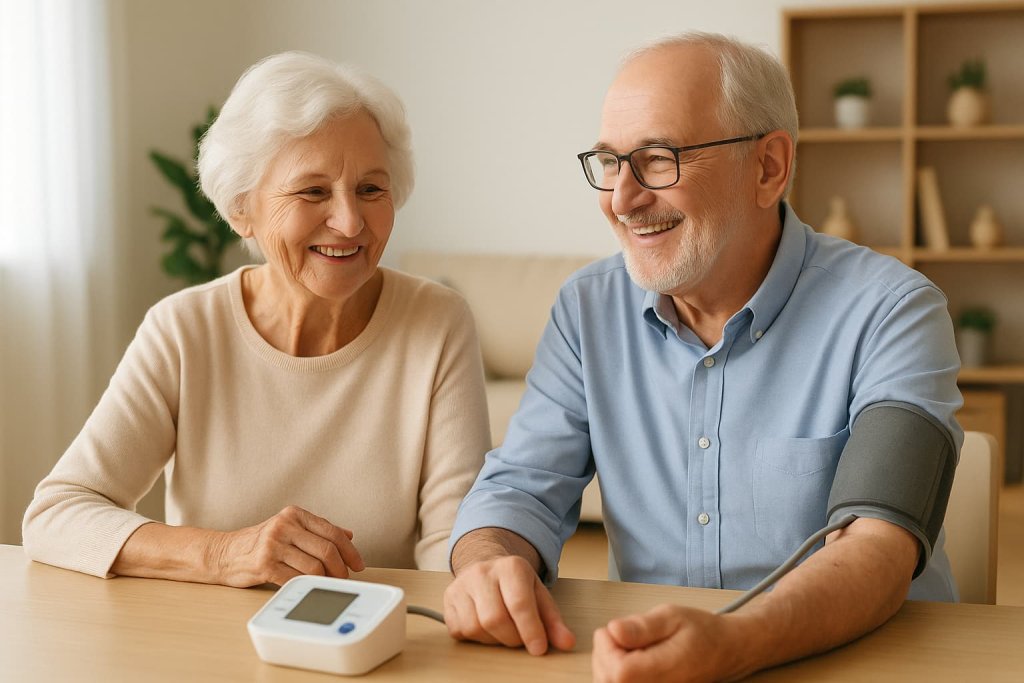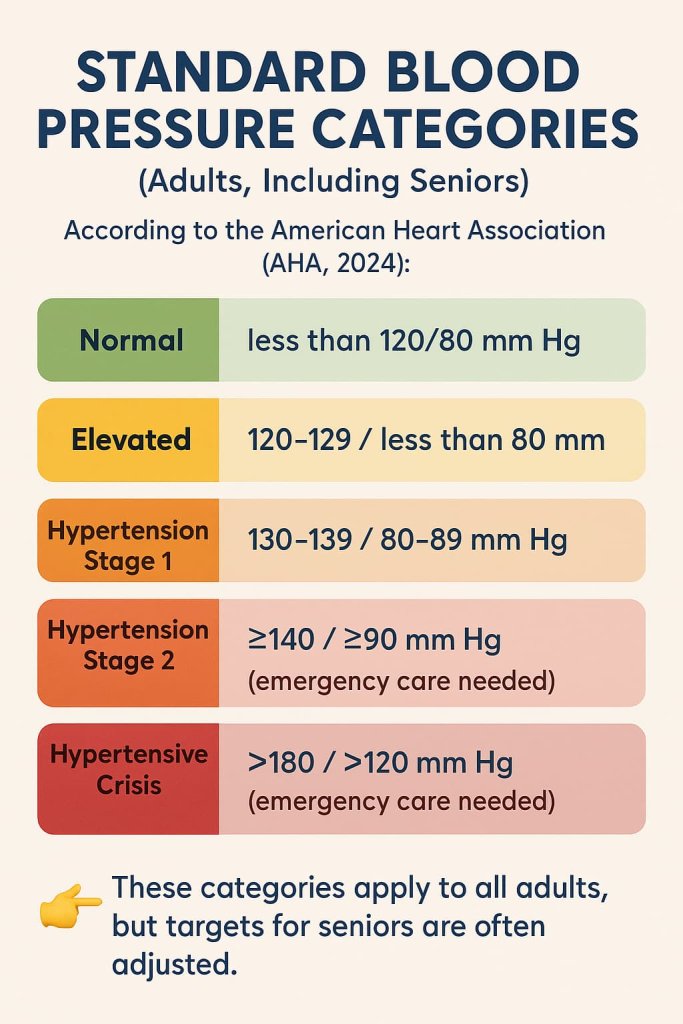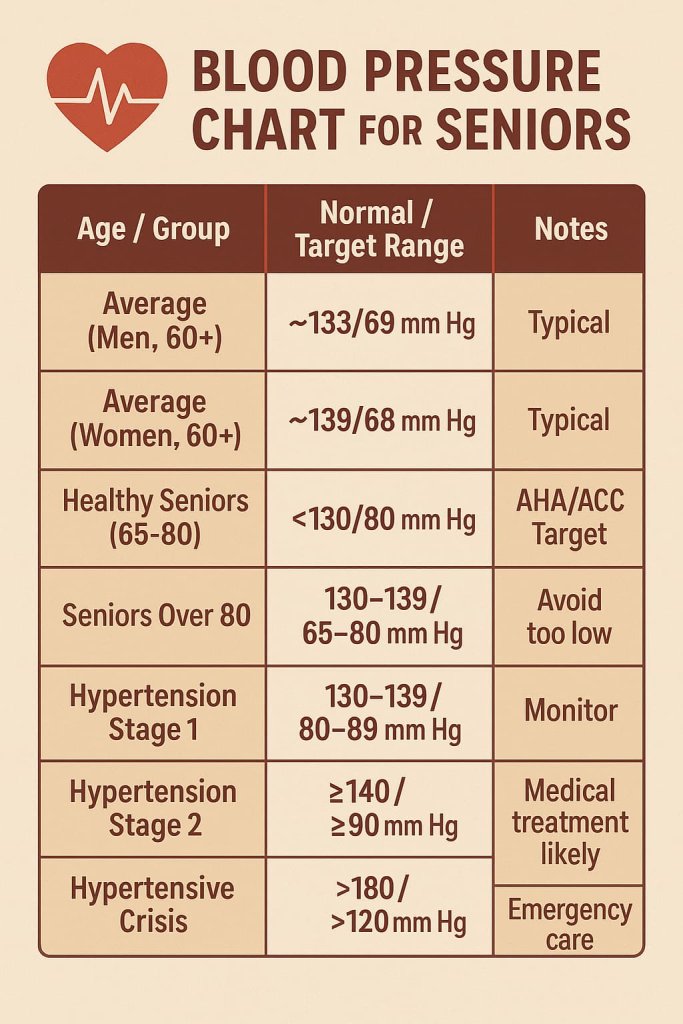The ideal blood pressure chart for seniors shows that most older adults should aim for readings below 130/80 mm Hg, while avoiding very low levels that may cause dizziness or falls.

Understanding blood pressure goals is essential for seniors because both high and low values can impact heart health, brain function, and overall quality of life. Seniors face unique changes in blood vessels and heart function, making regular monitoring and appropriate management even more important.
This guide breaks down the recommended blood pressure chart for seniors, what counts as normal or high, and how age affects the numbers. It also highlights the latest guidelines from trusted medical organizations and explains safe targets for older adults.
What Is Blood Pressure and Why It Changes with Age
Blood pressure measures the force of blood pushing against artery walls. It has two numbers:
- Systolic (top number): pressure when the heart beats
- Diastolic (bottom number): pressure when the heart rests
As people age, arteries naturally stiffen, often leading to higher systolic readings. This is why seniors may develop isolated systolic hypertension—where the top number is high, but the bottom number stays normal.
Standard Blood Pressure Categories (Adults, Including Seniors)

According to the American Heart Association (AHA, 2024):
- Normal: less than 120/80 mm Hg
- Elevated: 120–129 / less than 80 mm Hg
- Hypertension Stage 1: 130–139 / 80–89 mm Hg
- Hypertension Stage 2: ≥140 / ≥90 mm Hg
- Hypertensive Crisis: >180 / >120 mm Hg (emergency care needed)
👉 These categories apply to all adults, but targets for seniors are often adjusted.
Average Blood Pressure for Seniors
Research shows typical blood pressure values for older adults:
- Men (60+ years): around 133/69 mm Hg
- Women (60+ years): around 139/68 mm Hg
(Source: Baptist Health, 2024)
Recommended Target Blood Pressure for Seniors
Modern guidelines suggest different targets depending on age and health condition:
- Healthy Seniors (65–80 years): Aim for below 130/80 mm Hg (Miami Jewish Health, 2024)
- Seniors Over 80: Keep systolic between 130–139 and avoid dropping below 130/65 mm Hg to prevent dizziness, falls, or kidney stress (Verywell Health, 2024)
- Traditional Guidelines (Age 60+): Earlier recommendations allowed treatment only if blood pressure exceeded 150/90 mm Hg (AAFP)
Blood Pressure Chart for Seniors

| Age / Group | Normal / Target Range | Notes |
|---|---|---|
| Average (Men, 60+) | ~133/69 mm Hg | Typical |
| Average (Women, 60+) | ~139/68 mm Hg | Typical |
| Healthy Seniors (65–80) | <130/80 mm Hg | AHA/ACC Target |
| Seniors Over 80 | 130–139 / 65–80 mm Hg | Avoid too low |
| Hypertension Stage 1 | 130–139 / 80–89 mm Hg | Monitor |
| Hypertension Stage 2 | ≥140 / ≥90 mm Hg | Medical treatment likely |
| Hypertensive Crisis | >180 / >120 mm Hg | Emergency care |
Why Blood Pressure Control Is Critical in Seniors
- High BP Risks: Stroke, heart attack, kidney disease, memory decline
- Low BP Risks: Dizziness, fainting, falls, reduced organ perfusion
That’s why healthcare providers emphasize individualized targets, considering overall health, frailty, and medication side effects.
How Seniors Can Maintain Healthy Blood Pressure
- Regular monitoring: Home BP cuffs or pharmacy kiosks help track changes
- Balanced diet: DASH diet (fruits, vegetables, lean protein, low salt)
- Exercise: 20–30 minutes of walking, swimming, or light strength training
- Weight management: Even modest weight loss helps lower blood pressure
- Medication adherence: Never skip or double-dose without a doctor’s advice
- Stress management: Breathing, meditation, or light yoga
Learn more about DASH diet here (NIH).
People Also Ask (FAQs)
1. What is the normal blood pressure for a 70-year-old?
For most 70-year-olds, the target is below 130/80 mm Hg, though doctors may allow slightly higher levels if lower pressure causes dizziness.
2. Should seniors worry about low blood pressure?
Yes. While low BP may reduce heart risk, going below 130/65 mm Hg in seniors can cause weakness, fainting, or falls.
3. Is 140/90 high for a senior?
Yes. 140/90 mm Hg or above is hypertension, even in older adults, and usually requires lifestyle changes or medication.
4. How often should seniors check blood pressure?
At least once a week at home, or daily if under treatment. Always bring logs to doctor visits.
5. Can blood pressure fluctuate during the day?
Yes. Stress, meals, exercise, and medications can affect readings. Morning and evening checks give the most accurate picture.
6. What lifestyle changes help seniors lower blood pressure naturally?
Reducing salt, eating potassium-rich foods, daily walking, limiting alcohol, and stress management are proven methods.
7. What is considered dangerously high blood pressure for seniors?
A reading of 180/120 mm Hg or higher is a medical emergency—call 911 immediately.
Conclusion
Maintaining the right blood pressure is vital for seniors to stay healthy and independent. Most older adults should aim for below 130/80 mm Hg, but avoid going too low—especially beyond age 80.
By tracking readings, eating smart, staying active, and following medical advice, seniors can protect their heart and brain health for years to come.
👉 If you’re a senior or caregiver, start a weekly blood pressure log and share it with your healthcare provider at each visit.
References
- American Heart Association – Understanding Blood Pressure Readings
- Baptist Health – Healthy Blood Pressure by Age and Gender (2024)
- Miami Jewish Health – Blood Pressure Guidelines for Seniors
- Verywell Health – Blood Pressure and Aging (2024)
- American Academy of Family Physicians – Hypertension in Older Adults
- NIH – DASH Eating Plan
